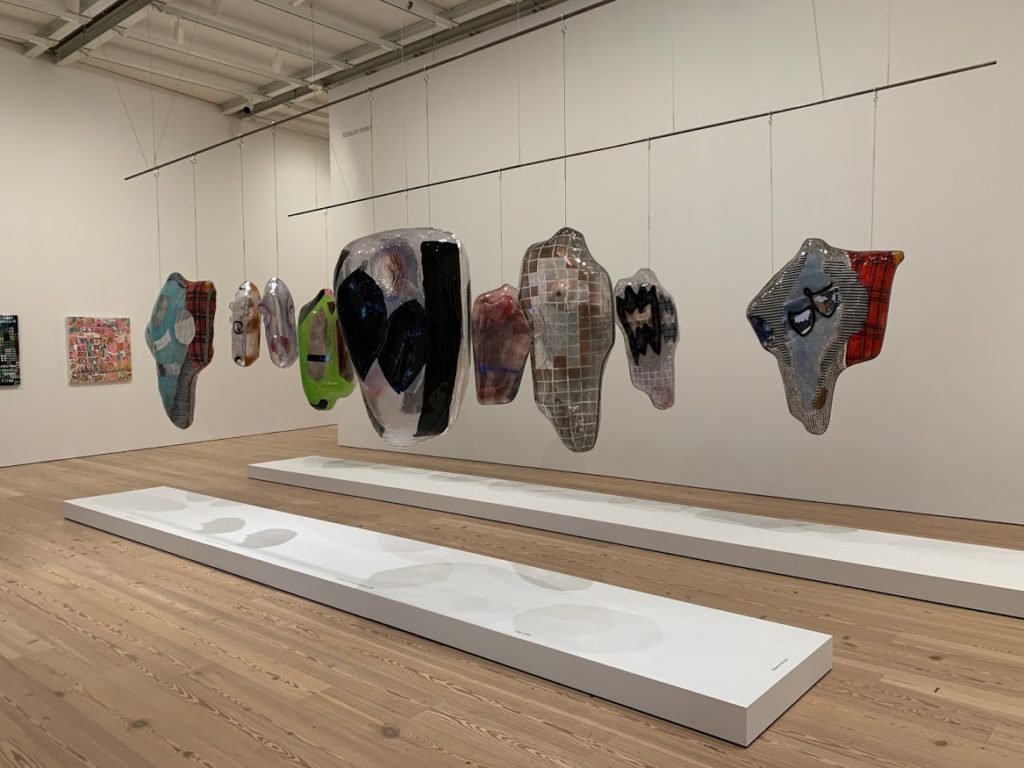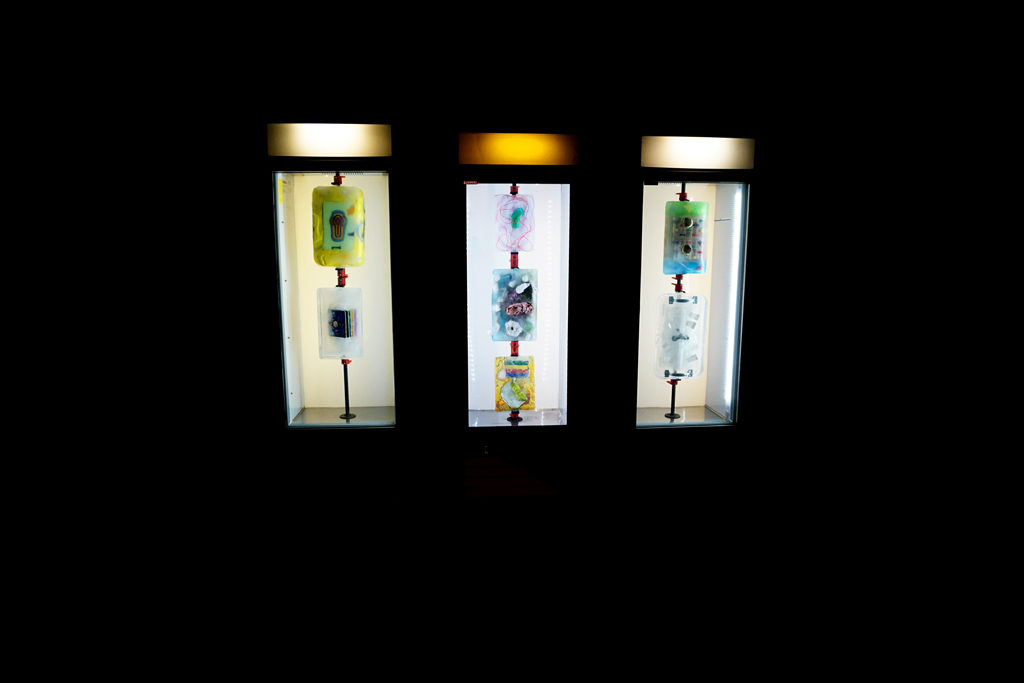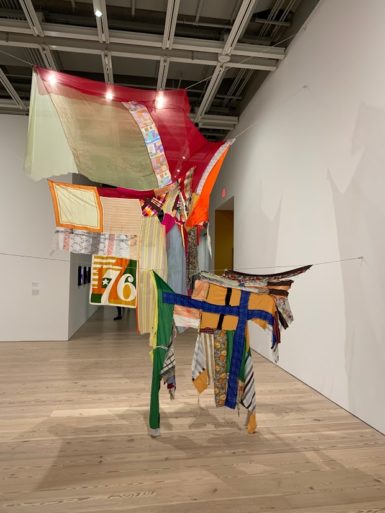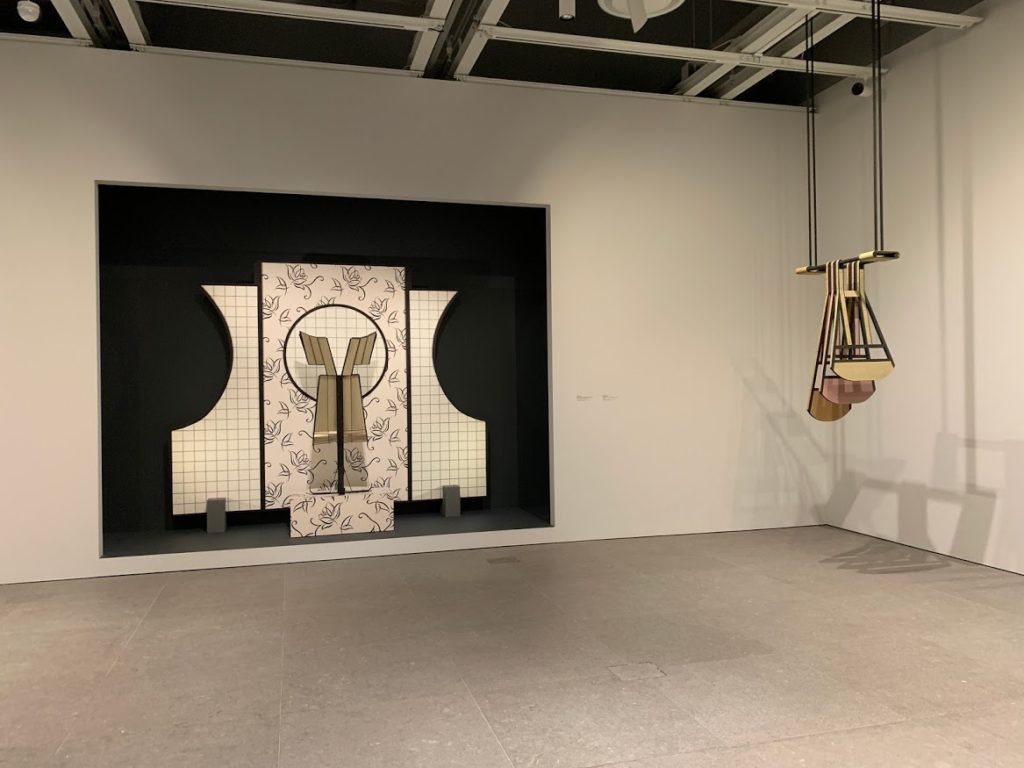[ad_1]

Works by Ragen Moss at the 2019 Whitney Biennial.
PHOTOS: ANDREW RUSSETH/ARTNEWS, EXCEPT WHERE NOTED
Lilting strings perform “The Star-Spangled Banner,” accompanying a tender animation of watercolors by Kota Ezawa that shows black football players, including Colin Kaepernick, kneeling to protest police brutality.
Clippings of racist media coverage of the Central Park Five, the black teenagers wrongfully convicted of murdering a white woman in 1989, hang along a wall—the work of Alexandra Bell, who has also included an ad signed by a private citizen, Donald J. Trump: “BRING BACK THE DEATH PENALTY. BRING BACK OUR POLICE!”
Voices emerge from an old tape player, sharing their fears for the Trump presidency, as recorded by Marcus Fischer just before Inauguration Day in 2017. “Fascism,” “white supremacy,” “the denial of science,” and “insanity taking over” are among the utterances.
The first Whitney Biennial assembled entirely during the Trump Administration has arrived. But despite such (mostly perfunctory) nods to the ongoing political morass, this is not a show of incendiary, radical responses. Artists are looking at how cities are being gentrified, how communities can be formed, and how power functions, in a register that is, for the most part, avowedly earnest—more melancholy than outraged.

Frozen works by Brian Belott.
MAXIMILIANO DURON/ARTNEWS
It is a very polite Biennial, in other words, and a fairly mixed affair. At times, it nearly becomes anodyne or boring, but then jolts of electricity—and visual delectation—arrive.
“Although much of the work presented here is steeped in sociopolitical concerns, the cumulative effect is open-ended and hopeful,” Jane Panetta and Rujeko Hockley, the Whitney curators who organized the show, write in an introductory text, summing things up nicely.
They have selected 75 artist and collectives—a bit more than the 63 of 2017, though you would never guess it because of their thoughtful, airy exhibition design. Nearly three-fourths of those participants are 40 or younger, more than half are non-white, half are women, and quite a few are among the most closely watched artists of the present moment. Those who regularly trawl galleries will know many of them; for the general population, this is a concise, accessible introduction to the contemporary scene.
The Biennial arrives as the Whitney is facing intense criticism for the presence on its board of Warren B. Kanders, the head of Safariland, which manufactures military supplies, including tear-gas canisters that have reportedly been used against migrants along the U.S.-Mexico border. One of the show’s participants, Forensic Architecture, has developed a computer program to identify when its canisters are used, and the group has worked with Laura Poitras and Praxis Films to contribute a short video, with a voiceover by David Byrne (of the Talking Heads), to explain their efforts. It is the Biennial’s big disappointment. The tone of the piece is oddly jaunty at points, suggesting the result of a bad-acting multinational corporation hiring a law firm and creative agency to conduct an investigation and then produce a hip, knowing mea culpa.

Pat Phillips, DON’T TREAD ON ME, 2019.
At a far end of one floor, Pat Phillips has painted a Leon Golub–indebted floor-to-ceiling tableau that includes a sign reading DON’T TREAD ON ME and real wooden fencing that partially obscures a big canister of tear gas labeled RIOT CONTROL. Like Poitras and Forensic Architecture’s video, it looks pre-approved, compromised agitprop, in this context. The very presence of these pieces certainly suggests that Whitney leadership is not particularly worried about them. That said, there is no telling how such work will look as protests inevitably continue during the show’s runs through September 22. More than half of the exhibition’s artists have signed a letter calling for Kanders to resign, and Michael Rakowitz pulled out before submitting work. For now, we’ll have to wait and see what happens.
It is not just the political mood that the Biennial is channeling. As in the city’s galleries, ramshackle collage and assemblage are out in force, and the superb Birmingham, Alabama–based septuagenarian Joe Minter is on hand as a godhead of inventive recycling. He’s presenting rough-hewn metal welded constructions that incorporate farming equipment—at once charismatic and a little frightening. They’re artifacts of, and tributes to, labor and the land.

Eric N. Mack, Proposition: for wet Gee’s Bend Quilts to replace the American flag—Permanently., 2019.
Robert Bittenbender is showing his wild, tense tangles of metal, wires, and street detritus, and Daniel Lind-Ramos, one of four Puerto Rico–based artists in the show, is a star, using everything from blue tarps distributed by FEMA to coconuts to ropes in service of building uncanny creatures that seem steeped in history. Eric N. Mack has never looked better, with an exuberant and carefully balanced mélange of disparate fabrics that are stitched together and hung from wires, nodding gallantly to Joe Overstreet, Gee’s Bend quilters, and Eva Hesse.
While there is some bland post-minimal fair (Iman Issa, Olga Balema) and portentous conceptualism (Agustina Woodgate) on hand, Mack’s seductive presence is exemplary of Panetta and Hockley’s refreshing commitment to aesthetic pleasure—which is never a given in a biennial situation. The great Chicago sculptor Diane Simpson, who’s turning 85 next year, gets the whole first-floor gallery for her irresistible geometric distillations of clothing, fabric, and window displays. (Note that this should not exempt another New York museum from doing a full-scale Simpson retrospective.)
Here, too, are Jennifer Packer, who makes explosively colorful, intimate, enigmatic portraits, and Brian Belott, who draws with unorthodox materials (mustard, hair gel) in water, which he then freezes and displays in freezers as models of free-wheeling play. And then there’s Lucas Blalock, whose digitally altered photographs are rollicking, surreal, joyous variations on straight photographs. (Do download his wacky augmented-reality app, Donkey Business, for use with his billboard at the High Line’s south end.)

Works by Diane Simpson.
Using photography quite differently, the unflinching Heji Shin has installed huge portraits of Kanye West in the basement near the coat check—an emblem of pure id grinding away down below. Many floors above, she’s showing babies being born in all their gory glory, a subject also picked up by Carissa Rodriguez in her masterful video The Maid (2018), which features Sherrie Levine’s copies of Constantin Brancusi’s Newborn (1915) in collectors’ homes. In Rodriguez’s hands, these sculptures are births forever frozen in time—they’re watched over, cleaned, and guarded constantly by their owners.
The deathly chill of Rodriguez’s gaze sets into stark relief the many works that show people changing or under threat, trying to figure themselves out or just show themselves to the world, through art.
“Who’s trying to fuck me over right now?” Martine Syms calls out in a funny, impressionistic video-photographic self-portrait of an installation, and Paul Mpagi Sepuya shoots himself in exhilarating, oblique self-portraits of his own. Strung up by wires, Ragen Moss’s nine awkward, luscious translucent polyethylene pieces vaguely recall bodies or cocoons, painted with playful references to Robert Motherwell, Charline von Heyl, and Simpson; they look tough but also a bit precarious. And I found myself strangely moved while seeing young female gymnasts tumbling through the air in Jeanette Mundt’s exquisite Giacomo Balla–like paintings, aiming to be perfect, if only for a moment.

Partial installation view of Nicole Eisenman, Procession, 2019.
Out on one of the Whitney’s roof decks, Nicole Eisenman has created what could be a monument to the opposite of that sensibility, reveling in imperfection. Her work is called Procession (2019), and it’s a troupe of 10 wildly disparate sculptural figures, all unwieldy and unusual in different ways, all pointed in one direction as they trudge along. Some are atop wheels, one person is riding on another’s back, and a giant up front is pulling along a prostate figure on a cart slapped with a bumper sticker that reads HOW’S MY SCULPTING? CALL 1-800-EAT-SHIT. (I called. It’s a phone sex line.)
It’s not clear if this is a celebration or a funeral march or something else entirely. It’s also impossible to know where they’re going, but you sense they are going to get there.
[ad_2]
Source link

